
Note ye ed's email address: stevebryant99@gmail.com. Season's greetings. 
|

Note ye ed's email address: stevebryant99@gmail.com. Season's greetings. 
|

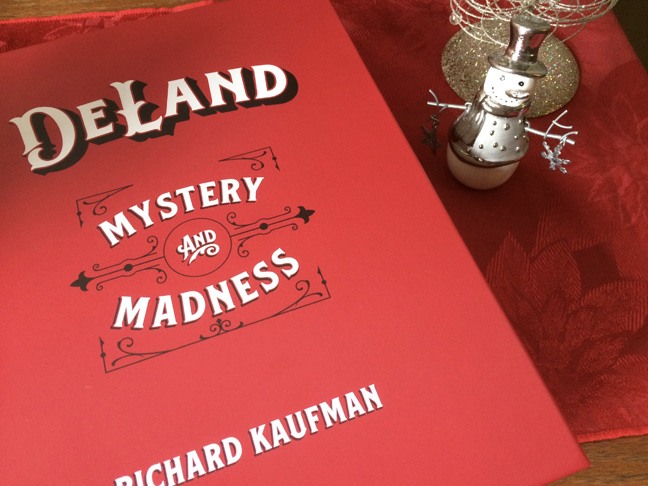
Ten pounds of Christmas cheer.
|
Return to our Thanksgiving issue for a look at Steve Cohen's graphic novel The Millionaires' Magician, Nick Trost's Subtle Card Creations Volume 1, Woody Aragon's Fortune Tarot, and Milt Larsen's Halloween radio broadcast. |
December 2018 Season's greetings! If you are wondering why this issue is a little late (it's Christmas Eve as I type these words), it's because the DeLand book arrived well into the month and it takes bloody forever to read, with over 600 pages of dense text and loads of fascinating information. What a Christmas gift! We also visit an overlooked Jim Steinmeyer title and bid a reluctant farewell to Ricky Jay. Dang. And as always, family makes life worth the trouble, and I'll close again with photos of my grandkids. From our new home, Maleficent and I wish you a very Merry Christmas, or whatever holiday suits your fancy, and a Happy New Year to all. Peace on Earth, good will to men. |
|
|
MAGIC MADE E-Z -- Santa Claus arrived early this Christmas, with a big red book in a big red box. I am speaking of course of DeLand Mystery and Madness, Richard Kaufman's two-decade passion project, a prodigious work by any measure. And as if that weren't enough, my stocking contains a deck of enough specially printed DeLand cards to accomplish 11 tricks. 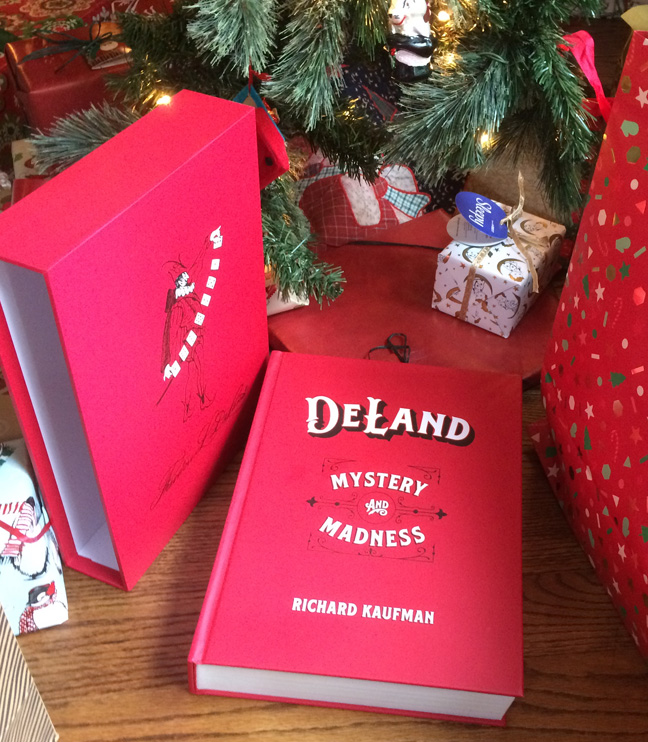 Look at what's under the Christmas tree! So where to begin? Just reading Jim Steinmeyer's Foreword and Richard Kaufman's Introduction makes one weep in appreciation that not only did one man, Theodore L. DeLand, Jr., create such wonderful, varied, and accessible magic, and that another, Richard, turned back the clock 100 years to chronicle that magic. As Richard lays it out, DeLand created baffling and easy to do card magic at a time when difficult sleights were the card conjurer's only resource, or when "easy" meant mathematical ruses. With DeLand's tricks, the magic was hidden in the cards themselves, through special printing or mechanical contrivance. Let's menton a few of the routines in order to demonstrate the scope of DeLand's creativity. The X-Ray Card Trick: Secret holes in half the cards allows you full view of the identity of the selection. Phantom Card Trick: Although my first exposure to DeLand may have been in a Mysto Magic set, I didn't really notice this trick until The New Book of Magic by Professor Paradise (Joseph Leeming, 1927). A spectator thinks of three cards of a hand of five, and the cards are covered with a handkerchief. Two are removed, not the selections, and the last three vanish. It went into my big show of fourth grade summer. The New Phantom Card Trick: The above trick uses double face cards, hence you can't show the backs. With this new version you can. Brilliant, and new to me until reading this book. The Disappearing Spots: Four threes become four aces which then become four blank cards. Pickitout: The printed Three Card Monte that eventually became the Michael Skinner and Mike Rogers versions. DeLand's Fade Away Card Trick: The printout of a human palm allows a palmed card to completely vanish. I first learned of this ploy in a Martin Lewis lecture, and it works beautifully. 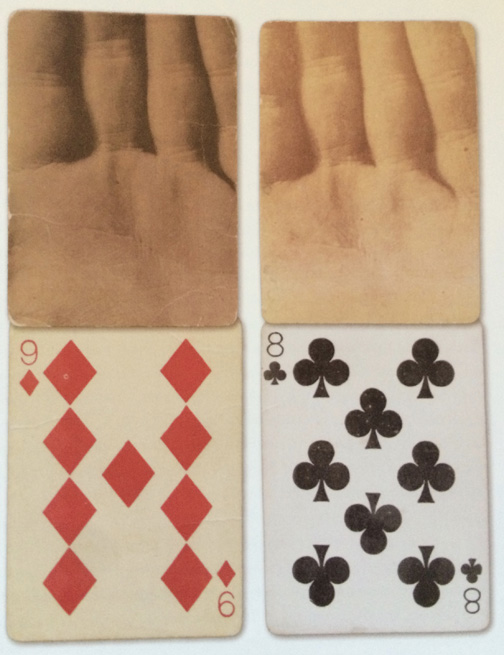 Would this fool anyone? You bet. The Peerless Monte-Cristo Cards: An early look at what would become known as the Tossed Out Deck. The Devil's Dream: A complex mind reading stunt that uses, among other things, an audio code similar to one devised recently by Lewis Jones (Ding Dong in As If By Magic). DeLand's "Beat It" Card Trick: Four tens and an ace are beneath a hank. The ace is removed and fanned at the hank. The tens all vanish to appear in various pockets. You end clean. Very clever. DeLand's Color Changing Card: A five of spades morphs into a five of diamonds. DeLand's Ace Trick: The gaffs, and the basic effect, of McDonald's Aces. An interesting way to force a target ace pile. Two Card Monte: Both Richard and I have encountered these in Christmas crackers, with a double back and a double face card. DeLand exposed the double backer for a laugh in his version. Max Maven provides a new version. Dollar Deck, Wonder Deck, etc.: DeLand experimented with marked, stacked, and stripped decks. All would be too fine for my vision. While many stack in CHaSeD order, DeLand stacked in DeLand Cards Have Superiority order. Vanishing Pack of Cards: (And later the Dope Deck.) A flat gaff looks like a three-dimensional deck. An early version of Aaron Fisher's Panic. DeLand's Inverto Card Trick: Twenty-six double backers and 26 regular cards allow the cards to magically straighten out a la Triumph. And many more, dozens more. Richard parses the creations out by periods, year by year, from DeLand's phase as golden boy of Wilson's Sphinx to his estrangement from that magazine and eventual fall into madness. He died in an institution in 1931. 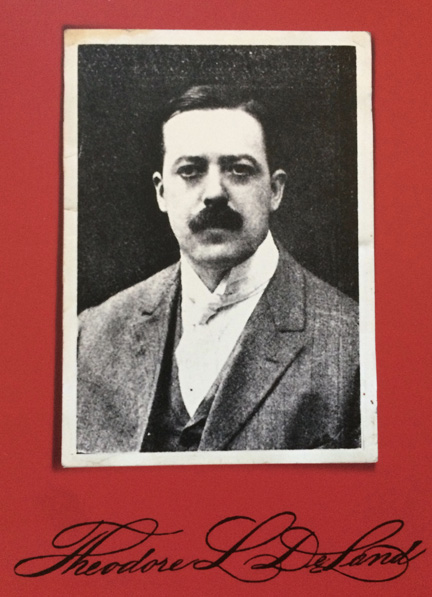 Magician of the year. After 552 pages of the main tale (in nine sections) come five appendices. Appendix I is Walter Gibson's 13 articles on DeLand that ran in The Conjuror's Magazine (43 pp), Appendix II is a DeLand Timeline (11 pp), Appendix III is a list of DeLand tricks included in Mysto Magic sets (2 pp), Appendix IV is a list of DeLand tricks included in the book [A.C.] Gilbert Card Tricks (1 pp), and Appendix V is a list of DeLand tricks sold by S.S. Adams (3 pp). The scope of the content and the book's physical presence are staggering. Features include the Steinmeyer Foreword and Kaufman Introduction; a fantastic caricature of DeLand by Steinmeyer; classy design by Brad Aldridge; editing by Ken Silverman, Tom Ransom, Matthew Field, Bill Mullins, and Dustin Stinett; and scholarship from a host of contributors. The book weighs in at 10 pounds, 608 pages, 9 by 12 inches plus box, available from Kaufman and Company, $150 plus $25 postage. A deck of DeLand gimmicked cards is included. Just a fascinating book that you will be proud to own. |
|
|
CASTING SPELLS -- For some of you, this will be a walk down memory lane. For me it was a brand new day. When Maleficent and I moved to new lodging last January, I was bummed that I could find only six of seven editions of Jim Steinmeyer's Impuzzibilities series. The second installment, Further Impuzzibilities, was missing. After searching here and there for months, I decided to check the contents, to determine exactly which tricks had escaped me. And duh, I came to realize that I had never purchased it. So, with $16 plus postage off to Jim, I now have the whole set. 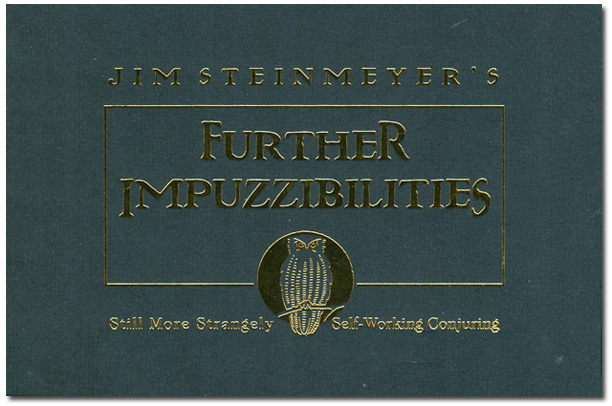 More E-Z magic. The book is subtitled Still More Strangely Self-Working Conjuring, and its ten items deliver. Several involve spelling, moving one card or coin for each letter spelled. Of these I liked The King's Coronation, which requires only the four kings. The second effect, Automatic Palmistry, involves only the spectator's hands. In other words, learn this and you are capable of doing magic anywhere, any time, for one person or a theater full. Some writers disdain mental effects where you do some math calculation, convert the numbers to letters or a line number, and eventully reveal a "random" word. I have a soft spot for such routines, and The Lesser Dictionary Test is such a beast. (The only problem is that some homes no longer have a dictionary handy!) Two feature routines begin with Five Fiends Play Blackjack. It looks like sleight of hand as you shuffle three times, dealing a blackjack hand after each shuffle and beating the mark by one point each time. Some of your best sleight-of-hand tricks may not look this good. And finally, The Thirteen Card Dilemma is similar to the Edward Victor Eleven Card Trick, but done with no sleights. When you add cards there are fewer; when you take cards away there are more. All with convincers along the way as you allow the spectator to do the counting. A funny routine! The usual format, softbound with foil cover, 30 pp, $16 plus postage at jimsteinmeyer.com. All seven booklets are highly recommended. |
|
|
ALOHA, RICKY JAY -- It's been a tough year for my magical heroes, with the losses of Harry Anderson, Brian Gillis, and, now as of November 24, Ricky Jay. All the major showbiz outlets ran generous obits, and the Genii forum erupted with tributes and video clips. Fom the clips it was fun to see a younger, wildly hirsute Ricky in action again, that goofy mix of skill and comedy, defined by New Yorker writer Mark Singer as "an out-of-left-field brand of gonzo-hip comedy magic, a combination of chops and antic irreverence." An esteemed scholar of magic and the Allied Arts, Ricky must have been keenly aware of his own mark in the field, as a card expert, a performing magician, a comic, an author, an actor (note that his career vastly outshined Houdini's), an athlete (he held the World Record for card tossing), and always a student. He was a student of Vernon and Slydini, pals with Persi Diaconis and Michael Weber, a collaborator with Steve Martin and David Mamet, an acquaintance of Linda Ronstadt and Bob Dylan. 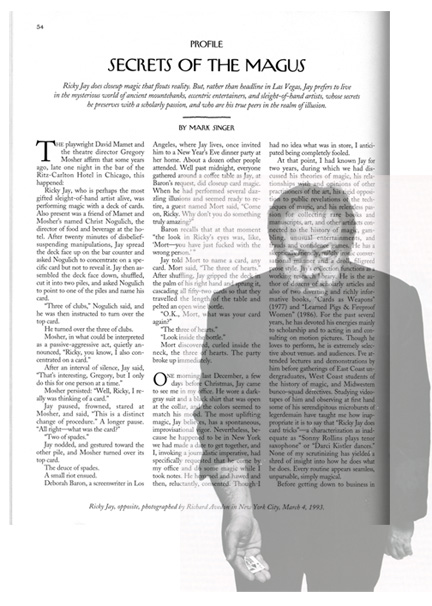 Ricky Jay in the magazine whose founder played poker with Harpo Marx. I encountered Ricky Jay live only once, in the seventies, in concert at San Diego State University. During his card-throwing stint, he claimed he could hit a wall over a hundred feet away. As the hurled card neared the wall, like a bullet, it passed right through the wall thanks to an open doorway. Not missing a beat, Ricky instantly quipped, "I meant of course the wall in the next room."It amused me years later to see much of this same seminal act on display in Ricky Jay and His 52 Assistants. The next closest I came to Ricky was when he spent some time here in Bloomington, researching blow books at Indiana University's Lilly Library. Alas, he didn't call. I later enjoyed a look at the collection and pondered Ricky's sitting there. Of the Genii forum links, I enjoyed the Interview with David Roth, new to me. (David was Ricky's backstage 53rd assistant on 52 Assistants.) And for the umpteenth time I re-read his 1993 New Yorker Profile, the best written of any magician anywhere. Two Ricky Jay characterizations surprised me on re-reading: One: He loved to play basketball. and Two: He and several friends formed an a cappella doo-wop group called Chico and the Deaf Tones. The Deaf Tones were five guys named Tony plus a girl named Laura. Their big number was "Tell Laura I Love Her." (Aside: New Yorker subscribers can also access Profiles of Dunninger, Penn and Teller, and Jamy Ian Swiss.) I am pleased for Ricky that he not only achieved the extremes of accomplishment in magic but also found love along the way. Of public knowledge, there was an early relationship with Tracy Newman, and eventually his recent wife Chrisann Verges, and, oh, did we youngsters ever adore the photos in Cards as Weapons. Among available video is the biographical documentary Deceptive Practice: The Mysteries and Mentors of Ricky Jay, and I will close with the same review that I ran on the occasion of its release, in October 2013. It's great. Ah, happier days. Aloha, Ricky Jay. The repeat article begins ... MIDNIGHT MOVIE -- One of the ways to make your mark in history as a sleight-of-hand artist is to perform once-in-a-lifetime tricks that others rave about, especially important "others." "Secrets of the Magus," the 1993 New Yorker Profile* on Ricky Jay, by Mark Singer, opens with two such card tricks. Of course, the real secret is to be the subject of such notice in the first place, to rate being the subject of a New Yorker Profile. As Steve Martin has written, you have to be so good they can't ignore you, and Ricky Jay has earned his notice both as a performer and as a historian and writer of magic. 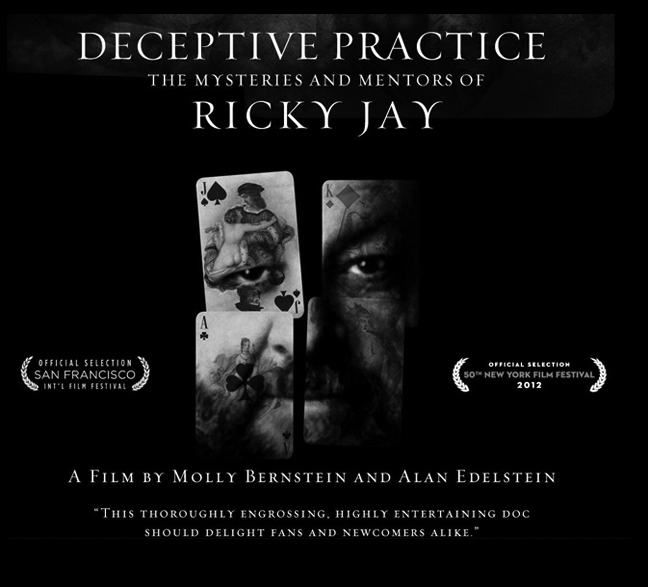 The Ricky Jay movie. The latest evidence of Ricky Jay's place in magic is the recently released film documentary, Deceptive Practice: The Mysteries and Mentors of Ricky Jay. The movie is listed as inspired by the New Yorker piece, and Mark Singer is listed as one of the co-executive producers. The film itself is a wonderful pastiche of Ken Burns-effect images from Ricky's historical files and more contemporary photos, video footage of such magi as Dai Vernon, Charlie Miller, Slydini, and Al Flosso, on-camera commentary from Persi Diaconis and Michael Weber, and of course footage of Ricky Jay himself performing and just practicing before mirrors, all deftly intertwined with the story of how Ricky Jay became Ricky Jay. Favorites of mine among the footage are Ricky as a boy magician, Ricky performing Three-Card Monte with Steve Martin bending the corner of a card, and Michael Weber performing his Matrix with nails in a board for Japanese television. (That last trick fools me so badly!) 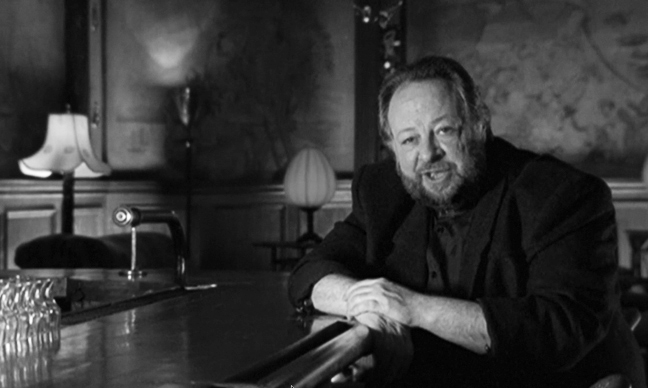 Ricky Jay weaves his tale. Unlike his mentors such as Dai Vernon, Charlie Miller, and Slydini, who never became wealthy through magic, Ricky Jay seems to have transcended the limited earnings of most close-up magicians and established himself as a member of upper echelon show business. Celebs involved with this film as either friends of Ricky or contributors to the project include Johnny Carson, Dinah Shore, David Mamet, Al Hirschfield, Dick Cavett, Steve Martin, Shel Silverstein (the film closes with a specially-written poem), Terry Gross, and Bob Dylan. A celeb not mentioned was Linda Ronstadt. At one point in my life I became fascinated by her and read everything I could about her. One piece had her riding around London in a limo with Ricky, the two betting on which of them might first appear on the cover of Time magazine. I remember thinking, "Screw Time magazine. If you are riding around London in a limo with Linda Ronstadt in her youth, life is already as good as it gets." (For the record, Linda hit the cover on February 28, 1977; Ricky rated a great three-page spread on February 14, 1994.) 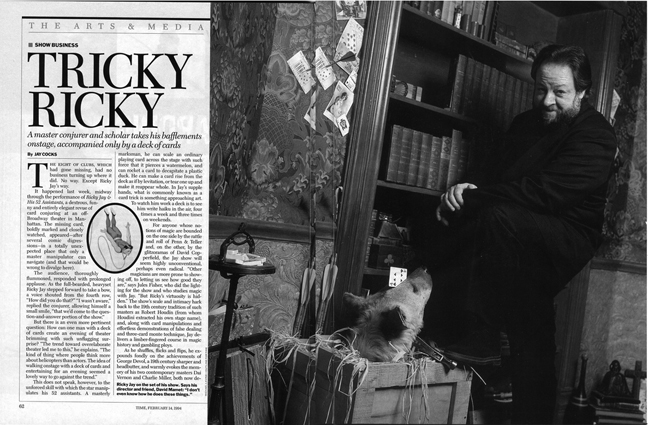 Ricky Jay in Time, 1994. I similarly note that admission to the upper echelons of magic tends to involve a couple of criteria, one being to have learned directly from the masters, which is the central point of this film, and the other being a disassociation with hoi polloi of magic, limiting one's friends to an exclusive few (this movie cites Persi Diaconis, Steve Freeman, David Roth, and Michael Weber). Celebrity associations and magic world reclusiveness also attend such stars as David Copperfield, Penn and Teller, and David Blaine. 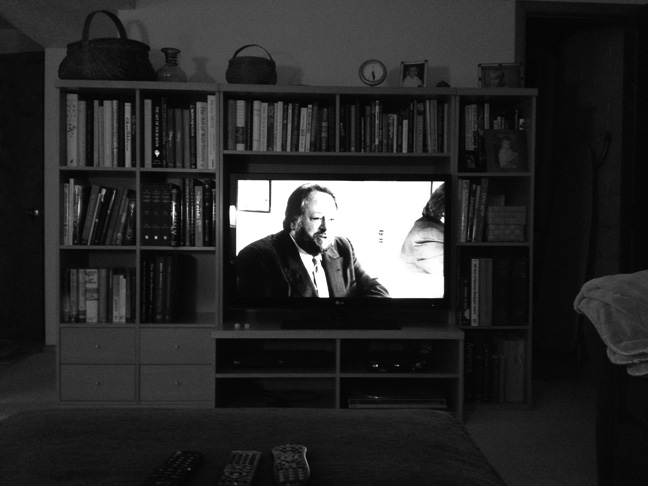 Watching Ricky's movie via Apple TV. There is of course much more to Ricky Jay than is covered in this movie (he has an enviable career as an actor in television and film, for example, along with being an important author and historian), but the movie does a beautiful job at what it sets out to do. This is a delightful film that will make you feel good about magic and good about Ricky Jay. Available on iTunes for only $12.99 HD, and highly recommended. *"Secrets of the Magus" by Mark Singer is available in full on The World Wide Website of Ricky Jay. |
|
 Charlie, Audrey, and Max.
Outside where smokers must retreat
Behold a new World Record feat As Ricky Jay hurls cards (no spoof) Over the Castle’s gabled roof. -- A Millennium Night's Dream
Follow us on Twitter. Little Egypt Magic is the erratically updated web site of Steve Bryant, spawned (the site, not Steve) by a former internet magazine known as The Little Egypt Gazette/for magicians only. Steve Bryant is an obscure magician and writer who generates this site from an iMac in Bloomington, Indiana. He used to frequently journey to and perform magic in Little Egypt, the local name for extreme southern Illinois, where the towns bear such names as Cairo, Thebes, and Karnak. Past issues of this web site: Index to Past Issues Notice: Any limited use of copyrighted images or quoted text is considered fair use, usually to review whatever product or event that is under discussion. If you object to use of any material, please get in touch and it will be cheerfully removed. |
A JSB Creations product
Copyright© 2018 by Steve Bryant